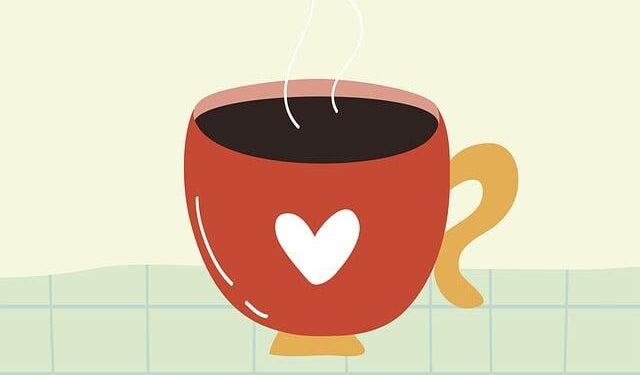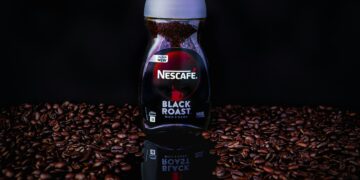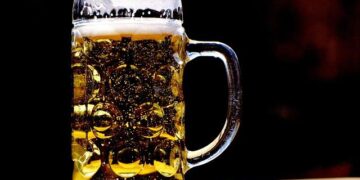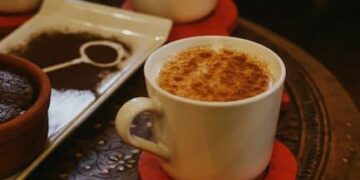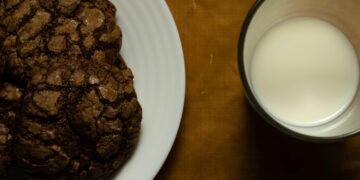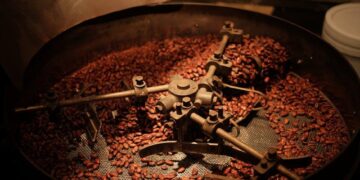Table of Contents
I used to think I was doing everything right.
As a home coffee enthusiast who had spent years perfecting pour-overs and dialing in espresso, I figured cold brew would be simple.
It’s just coffee and water, left to sit.
How hard could it be? I bought the fancy, cylindrical brewer, a top-of-the-line burr grinder, and bags of beautiful, single-origin beans.
I followed the internet’s gospel with near-religious fervor.
“Steep for 12 hours,” one guide commanded.
“No, 18 is the magic number,” insisted another.
A popular forum thread was adamant: “24 hours is the only way”.1
My kitchen became a laboratory of disappointment.
My first attempt was with a gorgeous, light-roast Ethiopian coffee, known for its bright, fruity notes.
Following the most common advice, I used an extra-coarse grind and steeped it for 12 hours on the counter.
The result was a thin, puckeringly sour liquid that tasted more like weak lemon water than coffee.2
It was a classic case of under-extraction, a brew that died before it ever had a chance to live.
Frustrated, I swung the pendulum to the other extreme.
I bought a dark, oily Sumatra roast, ground it coarsely, and let it steep for a full 24 hours.
This time, I was rewarded with a concentrate so harsh and bitter it was nearly undrinkable.
It tasted of ash and wood, a hollowed-out caricature of coffee flavor.4
This was over-extraction, and it was just as bad.
I was trapped.
I had followed the rules, but the rules were clearly broken.
The endless, contradictory advice about time wasn’t a guide; it was a maze.
It became clear that focusing on a single number—12, 18, or 24 hours—was like trying to navigate a city with only a street number and no street name.
The advice was missing the context, the system, the why.
There had to be a better way to think about it.
The Epiphany: Your Coffee Isn’t a Timer, It’s a Brisket
The breakthrough didn’t come from a coffee blog or a barista manual.
It came, oddly enough, while I was reading about Texas-style barbecue.
I was fascinated by the art of the pitmaster, who takes a tough, unpalatable cut of meat like a brisket and, through the meticulous management of a low-energy environment over a long time, transforms it into something tender and transcendent.
The science behind it was captivating.
Cooking a brisket “hot and fast” would create a charred, inedible exterior and a tough, chewy interior.
But cooking it “low and slow” works magic.
The gentle, consistent heat doesn’t just cook the meat; it initiates a profound chemical transformation.
Over many hours at a low temperature, the tough, fibrous collagen that makes the meat chewy breaks down and renders into succulent, mouth-coating gelatin.6
This process requires time; it cannot be rushed.
The pitmaster’s goal isn’t to hit a specific time on a clock, but to guide the meat to a state of perfect transformation.7
Suddenly, everything clicked into place.
Cold brew is the exact same principle applied to a different medium.
Hot brewing is “hot and fast.” The high temperature of near-boiling water is a brute-force method, rapidly dissolving a wide spectrum of compounds from the coffee grounds—including the volatile acids and oils that can lead to sharpness and bitterness.9
Cold brew, by contrast, is the “low and slow” barbecue of the coffee world.
By forgoing heat and relying on time, we create a gentle extraction environment.
The cold water is far more selective, slowly drawing out the desirable compounds like sugars and smooth-bodied flavor notes, while leaving many of the harsher, more acidic compounds behind in the grounds.11
This was the paradigm shift I needed.
The goal of making cold brew is not to “steep for X hours.” The goal is to manage extraction.
Time is not the instruction; it is merely one of the four critical dials on our cold brew “smoker.” Understanding how to adjust those dials is the true secret to making perfect cold brew, every single time.
The Pitmaster’s Toolkit: Mastering the Four Dials of Perfect Extraction
Thinking like a pitmaster means seeing cold brew not as a static recipe, but as a dynamic system with four interconnected variables.
Your “cut of meat” is your coffee roast.
Your “surface rub” is your grind size.
Your “smoker’s climate” is your brewing temperature.
And your “serving size” is your coffee-to-water ratio.
Master these four dials, and you master your brew.
Dial #1: The Roast (Your “Cut of Meat”)
Before a pitmaster even thinks about fire, they consider the meat.
A fatty pork shoulder behaves differently than a lean beef rib.
Likewise, your first and most important decision is the coffee you choose.
Groundbreaking research from the University of California, Davis, confirmed that roast level is the single most substantial driver of sensory differences in cold brew, more so than time or even temperature.13
The roasting process fundamentally changes the bean’s physical structure; darker roasts are more porous and soluble, readily giving up their flavors, while lighter roasts are denser and hold onto their compounds more stubbornly.14
- Dark Roasts: This is the classic, forgiving choice for cold brew. The extended roasting process makes these beans highly soluble, meaning they extract easily and consistently, even with a very coarse grind. They reliably produce that rich, chocolatey, low-acid flavor profile many people seek.14 If you are new to cold brew, this is the perfect place to start.
- Medium Roasts: This is the balanced choice, offering a beautiful middle ground. They are less dominated by “roast” flavor than dark roasts, allowing more of the bean’s inherent origin characteristics to shine through while still being relatively easy to extract.14 They produce a complex, flavorful, and smooth cup.
- Light Roasts: This is the expert’s choice, capable of producing stunningly bright, nuanced, and fruity cold brew. However, their high density and lower solubility make them prone to under-extraction, which results in sour, grassy, or weak coffee.14 To succeed with a light roast, you must actively compensate by turning up your other dials—either by extending the brew time or, more effectively, by using a finer grind.13
Table 1: The Pitmaster’s Guide to Coffee Roasts
| Roast Level | Flavor Profile & Characteristics | Recommended Starting “Dial” Settings |
| Light Roast | Bright, acidic, fruity, tea-like. Denser bean, less soluble. Prone to sourness if under-extracted. | Time: 18-24 hours. Grind: Medium-coarse. Temp: Room temp helps aid extraction. |
| Medium Roast | Balanced, sweet, complex. Reveals more origin character. A versatile and flavorful choice. | Time: 16-20 hours. Grind: Coarse. Temp: Room temp or fridge. |
| Dark Roast | Rich, chocolatey, bold, low-acidity. Porous bean, highly soluble. Very forgiving. | Time: 12-18 hours. Grind: Extra-coarse. Temp: Room temp or fridge. |
Dial #2: The Grind (Your “Surface Area Rub”)
A barbecue rub must cover the surface of the meat to create a flavorful crust.
In coffee, your grind size determines the total surface area of the grounds exposed to water, which directly controls the speed of extraction.19
This is your primary accelerator or brake pedal.
The conventional wisdom to always use an extra-coarse grind (like rock salt or peppercorns) is born from a place of caution.21
The logic is that over a long steep, a coarse grind provides insurance against over-extraction and bitterness.
While this is a safe starting point, it is often suboptimal and is the very reason my light roast brew failed so spectacularly.
The deeper truth is that grind size is a compensatory tool.
An experiment that tested multiple batches found that for a 12-hour steep, a medium-coarse grind produced a tastier, more fully extracted coffee than a coarse grind, challenging the “coarser is always better” myth.4
- If your brew tastes sour and thin, it’s under-extracted. You need to speed up extraction. The most effective fix is to grind finer for your next batch.2
- If your brew tastes bitter and harsh, it’s over-extracted. You need to slow down extraction. The solution is to grind coarser.2
For this dial to work, consistency is paramount.
A blade grinder pulverizes beans into a chaotic mix of fine dust and large boulders.
The dust over-extracts immediately (creating bitterness), while the boulders under-extract (adding sourness), resulting in a muddled, disappointing cup.
A quality burr grinder, which mills beans to a uniform size, is the single best equipment investment you can make for better coffee of any kind, especially cold brew.15
Dial #3: The Temperature (Your “Smoker’s Climate”)
A pitmaster can choose to run their smoker at a low 225°F or a slightly hotter 275°F, a decision that impacts the cooking time and final texture of the meat.
As a cold brewer, you have a similar choice: brew in the refrigerator or on the countertop.
This dial sets the overall pace of your extraction.
The science is simple: chemical reactions, including extraction, slow down significantly at lower temperatures.12
- Fridge Brew (approx. 4°C / 40°F): This is the truest “low and slow” method. The cold temperature slows extraction way down, meaning you’ll need a longer steep time—typically 18 to 24 hours or more—to achieve full flavor.27 The reward for your patience is often a remarkably smooth, clean, and sweet cup, as the colder water is even more selective in the compounds it dissolves. This method is also more forgiving if you forget about it for a few extra hours.
- Countertop Brew (approx. 22°C / 72°F): This is the relatively “faster” method. At room temperature, extraction happens much more quickly, and you can often achieve a fantastic result in 12 to 18 hours.27 The resulting brew is often described as being bolder and more full-bodied than its refrigerated counterpart.
There is no single “correct” temperature.
It’s a trade-off.
Fridge brewing demands more time but offers a cleaner profile and a wider margin for error.
Countertop brewing is faster but requires you to be more mindful of your timing to avoid over-extraction.
Dial #4: The Ratio (Your “Serving Size”)
A pitmaster needs to know if they’re cooking a single rack of ribs or feeding a crowd.
Your coffee-to-water ratio determines the final strength of your brew and whether you’re making a potent concentrate or a beverage that’s ready to drink as-Is. To avoid confusion, always measure by weight (grams) using a kitchen scale, as measuring by volume (cups) is notoriously inaccurate for coffee grounds.25
- Concentrate Ratios (1:4 to 1:8): This means 1 gram of coffee for every 4 to 8 grams of water. This is the most common and versatile approach, producing a strong, syrupy concentrate that is meant to be diluted.30 You can dilute it with water, milk, or ice to your desired strength, giving you maximum control over the final cup. A 1:8 ratio (e.g., 100g of coffee to 800g of water) is a perfect, well-rounded starting point for a concentrate.32
- Ready-to-Drink Ratios (1:12 to 1:16): This means 1 gram of coffee for every 12 to 16 grams of water. This method produces a brew that is already at a drinkable strength, similar to a standard cup of drip coffee.34 It’s a simpler, more direct method, but offers less flexibility after the brew is complete.
For most people, starting with a concentrate ratio like 1:8 provides the best of both worlds: a strong base that can be customized for any preference or application.
Tasting is Testing: How to Read Your Brew and Perfect the Recipe
A great pitmaster doesn’t rely on a timer; they know the meat is done by feel, sight, and temperature.
A great cold brewer must learn to do the same with their palate.
Your taste buds are the ultimate diagnostic tool.
By learning the language of extraction, you can turn any brew—good or bad—into a lesson that gets you closer to perfection.
Speaking the Language of Extraction
Every cup of coffee tells a story about its extraction.
You just need to learn how to listen.
The primary flavors of coffee extract in a sequence: first come the fruity and acidic compounds, then the sweet and balanced notes, and finally, the bitter compounds.2
- Under-Extraction: The Sour Truth. This is the taste of a brew that was stopped too early. The water pulled out the initial bright acids but didn’t have enough time to extract the balancing sweetness. The result is a coffee that tastes sour, unpleasantly sharp, sometimes salty, with a thin, watery body and a quick, unsatisfying finish.3 It’s the flavor of unripe fruit.
- Over-Extraction: The Bitter End. This is a brew that went on for too long. After all the sugars were extracted, the water started pulling out an excess of bitter-tasting compounds. The result is a coffee that is overwhelmingly bitter, drying or astringent (like black tea that steeped for ten minutes), and tastes hollow or lifeless.3 It can also take on unpleasant
woody or burnt flavors.4 It’s the flavor of burnt toast. - The “Golden Cup” Balance: This is the sweet spot. A perfectly extracted brew has a rich sweetness that balances its inherent acidity. It has a pleasant weight and body in your mouth and a long, lingering, and enjoyable aftertaste. This is your perfectly rendered, juicy brisket.
The Troubleshooting Framework: Adjusting Your Dials
Once you can diagnose the problem, the solution is simply a matter of turning the right dial.
Use this framework to perfect your recipe.
- If your coffee is SOUR (Under-extracted)…
You need to extract more. Make one adjustment at a time.
- Turn Dial #2 (Grind): Grind finer. This is the most powerful and immediate fix.
- Turn Dial #1 (Time): Steep longer. Add 2-4 hours to your next brew.
- Turn Dial #3 (Temp): Brew warmer. Move from the fridge to the countertop.
- If your coffee is BITTER (Over-extracted)…
You need to extract less.
- Turn Dial #2 (Grind): Grind coarser.
- Turn Dial #1 (Time): Steep shorter. Reduce your time by 2-4 hours.
- Turn Dial #3 (Temp): Brew colder. Move from the countertop to the fridge.
- If your coffee is WEAK…
This could be under-extraction or simply a matter of ratio. If it’s weak and sour, see the under-extraction fix above. If it tastes balanced but just isn’t strong enough, you need to adjust your ratio.
- Turn Dial #4 (Ratio): Use more coffee. Move from a 1:10 ratio to a 1:8 ratio, for example.
Table 2: The Cold Brew Troubleshooting Guide
| If Your Coffee Tastes… | It Means… | Try This Adjustment… |
| Sour, Weak, Salty, Grassy | Under-Extracted | Increase extraction. Grind finer OR steep longer. |
| Bitter, Harsh, Drying, Woody | Over-Extracted | Decrease extraction. Grind coarser OR steep shorter. |
| Muddy, Gritty | Poor Filtration | Filter again through a finer medium (e.g., paper filter, double-layered cheesecloth). |
| Perfect, but too Strong/Weak | Ratio is Off | The brew is good! Adjust the dilution with water/milk after brewing, or use a different brew ratio next time. |
The Conclusion: You Are the Pitmaster
My journey into cold brew began with frustration, following rigid, context-free rules that led to failure.
The epiphany was realizing that cold brew isn’t about hitting a number on a clock; it’s about managing a delicate, slow transformation, just like barbecue.
You are no longer a slave to a random number you read online.
You are now the pitmaster of your own brew.
You have the toolkit—the four dials of Roast, Grind, Temperature, and Ratio.
You have the diagnostic method—your own palate, trained to recognize the difference between sour under-extraction and bitter over-extraction.
The path to your perfect cup is a process of discovery.
To start you on that journey, here is a forgiving, all-purpose recipe designed to be your launching point.
- The Bean (Cut of Meat): A good quality Medium-Dark Roast.
- The Ratio (Serving Size): 1:8 (e.g., 100 grams of coffee to 800 grams of water) to make a concentrate.
- The Grind (Surface Rub): Coarse, like coarse sea salt.
- The Brew (Climate & Time): Steep on your countertop for 16 hours.
After 16 hours, strain it and taste it.
Dilute it 1:1 with water or milk and taste again.
Is it perfect? Wonderful.
Is it a little bitter? For your next batch, try grinding a little coarser or steeping for only 14 hours.
Is it a touch weak or sour? Try steeping for 18 hours.
The perfect cold brew isn’t a destination you find on a map.
It’s a recipe you build yourself, one delicious, well-understood batch at a time.
Now you have the framework.
Go brew.
Works cited
- How long do you steep your cold brew? : r/Coffee – Reddit, accessed August 3, 2025, https://www.reddit.com/r/Coffee/comments/cv5ywx/how_long_do_you_steep_your_cold_brew/
- Coffee Extraction & How It Helps Create The Perfect Cup, accessed August 3, 2025, https://perfectdailygrind.com/2018/11/understanding-coffee-extraction-for-your-perfect-cup/
- Coffee Extraction and How to Taste It – Over/Under Extracted Coffee, accessed August 3, 2025, https://www.baristahustle.com/coffee-extraction-and-how-to-taste-it/
- How Long To Steep Cold Brew – We Tested, accessed August 3, 2025, https://thatscoldbrew.com/how-long-to-steep-cold-brew/
- Tasting Coffee Extraction: Under and Overextracted Coffee – Tastify, accessed August 3, 2025, https://www.tastify.com/article/tasting-coffee-extraction-under-and-overextracted-coffee
- The Science of Cooking BBQ: Slow vs. Fast – Life Tastes Good – Byron Talbott, accessed August 3, 2025, https://www.byrontalbott.com/the-science-of-cooking-bbq-slow-vs-fast/
- The Science Behind Cooking Meat Low And Slow – Chowhound, accessed August 3, 2025, https://www.chowhound.com/1693494/why-cook-low-and-slow/
- The Art or Science of Low & Slow? – Meat Smoke Fire, accessed August 3, 2025, https://meatsmokefire.co.uk/blog/the-art-or-science-of-low-slow/
- The Chemistry of Brewing Cold Brew Coffee: A Deep Dive, accessed August 3, 2025, https://torque.coffee/blogs/brew-guides/the-chemistry-of-brewing-cold-brew-coffee-a-deep-dive
- Cold Brew – the science, the art – Rare Breed Coffee, accessed August 3, 2025, https://rarebreedcoffee.com/blogs/coffee-origins/cold-brew-the-science-the-art
- How Long Does Cold Brew Need to Steep: A Comprehensive Guide – Golden Cava, accessed August 3, 2025, https://goldencava.com/blogs/coffee/how-long-does-cold-brew-need-to-steep
- The science behind cold brew extraction: How does it really work? – Hardtank, accessed August 3, 2025, https://hardtank.com/2025/05/06/science-of-cold-brew-extraction/
- Cold Brew Research: Temperature and Time Less Impactful than …, accessed August 3, 2025, https://dailycoffeenews.com/2025/03/11/cold-brew-research-temperature-and-time-less-impactful-than-roast-level/
- Which Roast Should You Choose For Your Cold Brew Coffee?, accessed August 3, 2025, https://kunjaninaples.com/blogs/kunjani-blog/cold-brew-roast-level
- The Importance of Grind Size – North Star Coffee Roasters, accessed August 3, 2025, https://www.northstarroast.com/blogs/brewing/the-importance-of-grind-size
- How to cold brew coffee the right way, accessed August 3, 2025, https://traditioncoffeeroasters.com/blogs/coffee-collective/how-to-cold-brew-coffee
- Are specific roasts or blends better for making cold brew at home? – Coffee Stack Exchange, accessed August 3, 2025, https://coffee.stackexchange.com/questions/5714/are-specific-roasts-or-blends-better-for-making-cold-brew-at-home
- Light or dark roast for cold brew? : r/Coffee – Reddit, accessed August 3, 2025, https://www.reddit.com/r/Coffee/comments/4ynfuk/light_or_dark_roast_for_cold_brew/
- Coffee Grind Size Chart: How Grind Size Affects Coffee Flavor – 2025 – MasterClass, accessed August 3, 2025, https://www.masterclass.com/articles/coffee-grind-size-chart
- The Complete Guide to Coffee Grind Size, accessed August 3, 2025, https://www.drinktrade.com/blogs/how-to/coffee-grind-size-chart
- The Ultimate Guide to Making Cold Brew Coffee – Cartel Roasting Co, accessed August 3, 2025, https://cartelroasting.co/the-ultimate-guide-to-making-cold-brew-coffee/
- Cold Brew 101 – All About The Grind – Takeya USA, accessed August 3, 2025, https://takeyausa.com/blogs/fitness-healthy-living/cold-brew-101-all-about-the-grind
- How to Grind Coffee for Cold Brew – 4 Easy Step (2025) – Kimbo …, accessed August 3, 2025, https://www.kimbocoffee.com/blogs/kimbo-blog/how-to-grind-coffee-for-cold-brew
- 10 Mistakes Everyone Makes With Homemade Cold Brew, According To An Expert Barista, accessed August 3, 2025, https://www.foodie.com/1528341/mistakes-steeping-cold-brew-list/
- I figured it out! (Cold Brew Guide) : r/Coffee – Reddit, accessed August 3, 2025, https://www.reddit.com/r/Coffee/comments/k4zhv6/i_figured_it_out_cold_brew_guide/
- How Temperature Affects The Taste Of Cold Brew, accessed August 3, 2025, https://www.tastingtable.com/932917/how-temperature-affects-the-taste-of-cold-brew/
- Best leaching time for Cold Brew – Green Plantation, accessed August 3, 2025, https://www.greenplantation.com/a/best-leaching-time-for-cold-brew
- Making cold brew: on the counter or in the fridge? – Shelbru, accessed August 3, 2025, https://www.shelbru.com/blogs/blog/making-cold-brew-on-the-counter-or-in-the-fridge
- Cold Brew Coffee – Room Temperature or Refrigerator? – DripBeans, accessed August 3, 2025, https://dripbeans.com/cold-brew-coffee-room-temperature-or-refrigerator/
- Cold Brew Coffee 101—Your Complete Guide to the Best Brew – CoffeeSock, accessed August 3, 2025, https://coffeesock.com/the-sock-life-1/2021/4/11/cold-brew-coffee-101your-complete-guide-to-the-best-brew
- Coffee-to-Water Ratio: The Ultimate Guide to Brewing Ratios …, accessed August 3, 2025, https://methodicalcoffee.com/blogs/coffee-culture/coffee-to-water-ratio-the-ultimate-guide-to-brewing-ratios
- counterculturecoffee.com, accessed August 3, 2025, https://counterculturecoffee.com/blogs/counter-culture-coffee/guide-to-cold-brew
- The Ultimate Guide on Making Cold Brew Coffee Concentrate – Sunday Table, accessed August 3, 2025, https://sundaytable.co/cold-brew-coffee-concentrate/
- 1:20 ration for Cold brew? : r/JamesHoffmann – Reddit, accessed August 3, 2025, https://www.reddit.com/r/JamesHoffmann/comments/16arpp8/120_ration_for_cold_brew/
- Best Ratio for Cold Brew? : r/Coffee – Reddit, accessed August 3, 2025, https://www.reddit.com/r/Coffee/comments/w62ewa/best_ratio_for_cold_brew/
